► We live with the Lamborghini Huracan Evo
► Video road test and full UK review
► Junior Lambo supercar as daily driver
It’s incredible to think that the Lamborghini Huracan is the first step up Sant’Agata’s supercar ladder: there’s not very much that’s junior or entry-level about this dramatic slice of V10 mid-engined exotica.
CAR magazine is lucky enough to be living with this exact car in spring 2023 and you can watch it in action in our video above. Can you really live with a Huracan Evo as your daily driver? What’s the luggage space like? And is it a slidey nightmare in a typical British winter, or the consummate all-seasons supercar?
Read on for our Lamborghini Huracan Evo review and long-term test diaries.
Want to access more amazing content from CAR? Become a Subscriber of CAR here.
The 2023 Lamborghini Huracan Evo: what’s new on the latest version?
The Huracan has been with us since it replaced the Lamborghini Gallardo all the way back in 2014, so it’s not far off a decade old now. It was last updated in 2019 and that’s why it wears the Evo tag (for evoluzione). It’s available in rear- or all-wheel drive (our yellow long-termer pictured is the Evo AWD in look-at-me Giallo Belenus paint).
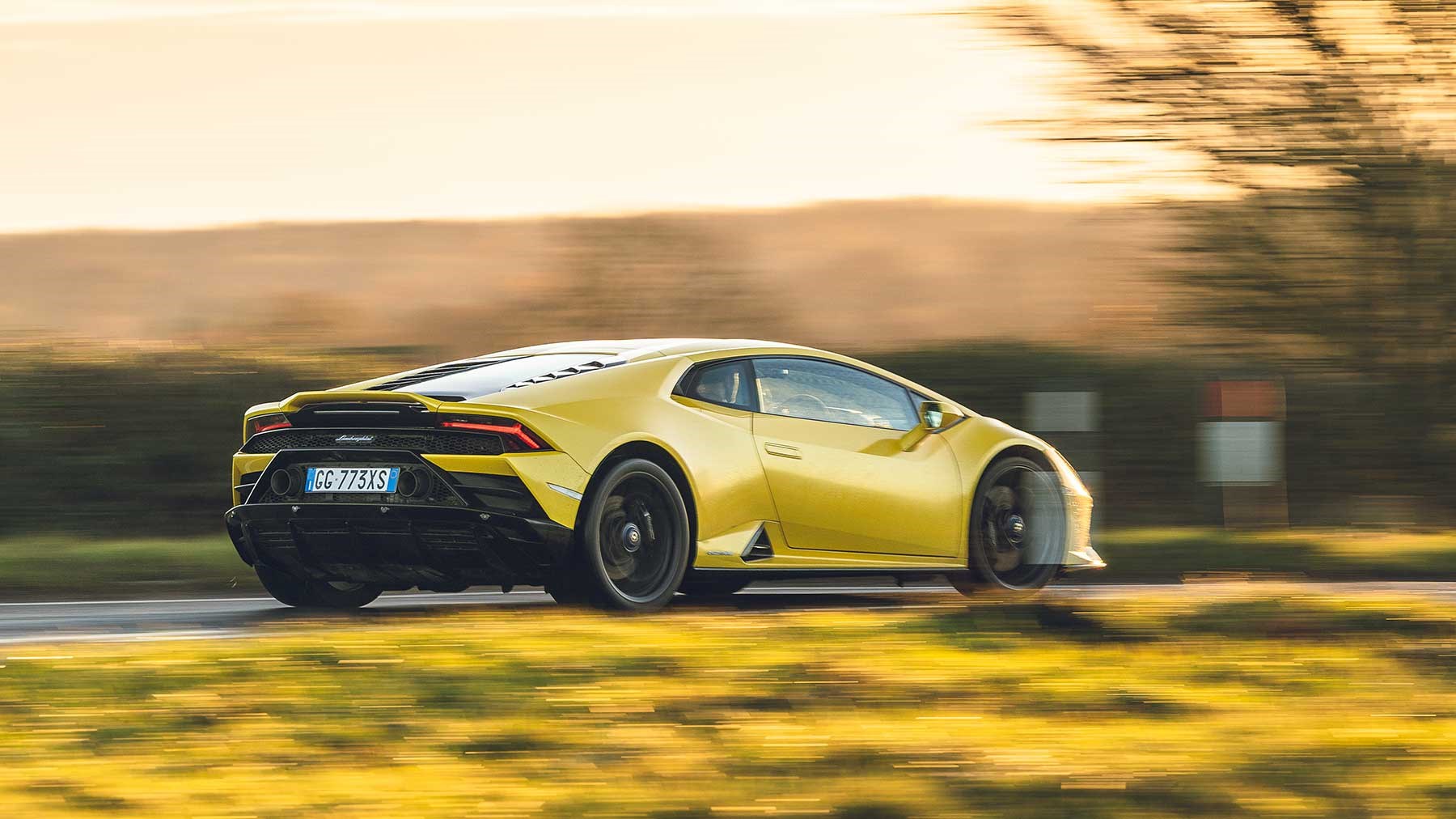
Spot the Evo by its front bumper, entirely reprofiled in the name of improved aerodynamics and cooling, while at the rear the spoiler became a slotted double-decker ducktail, to better extract hot air and massage the flow of exhaust gases (from new, higher-mounted outlets) as well as increase downforce, above a new diffuser design.
Under the floor too, there are redesigned deflectors to increase downforce without significantly penalising drag. Overall, Lamborghini claims a seven-times improvement in downforce compared with the previous regular Huracan.
Inside, a new touchscreen (below) embedded in the centre console replaces the previous button and dial-based controls for infotainment, climate control and more. It works well enough, though you have to learn particular hand movements – like an Apple Mac, you need two-fingered swipes to do things like volume control. It can prove a little fiddly on the move.
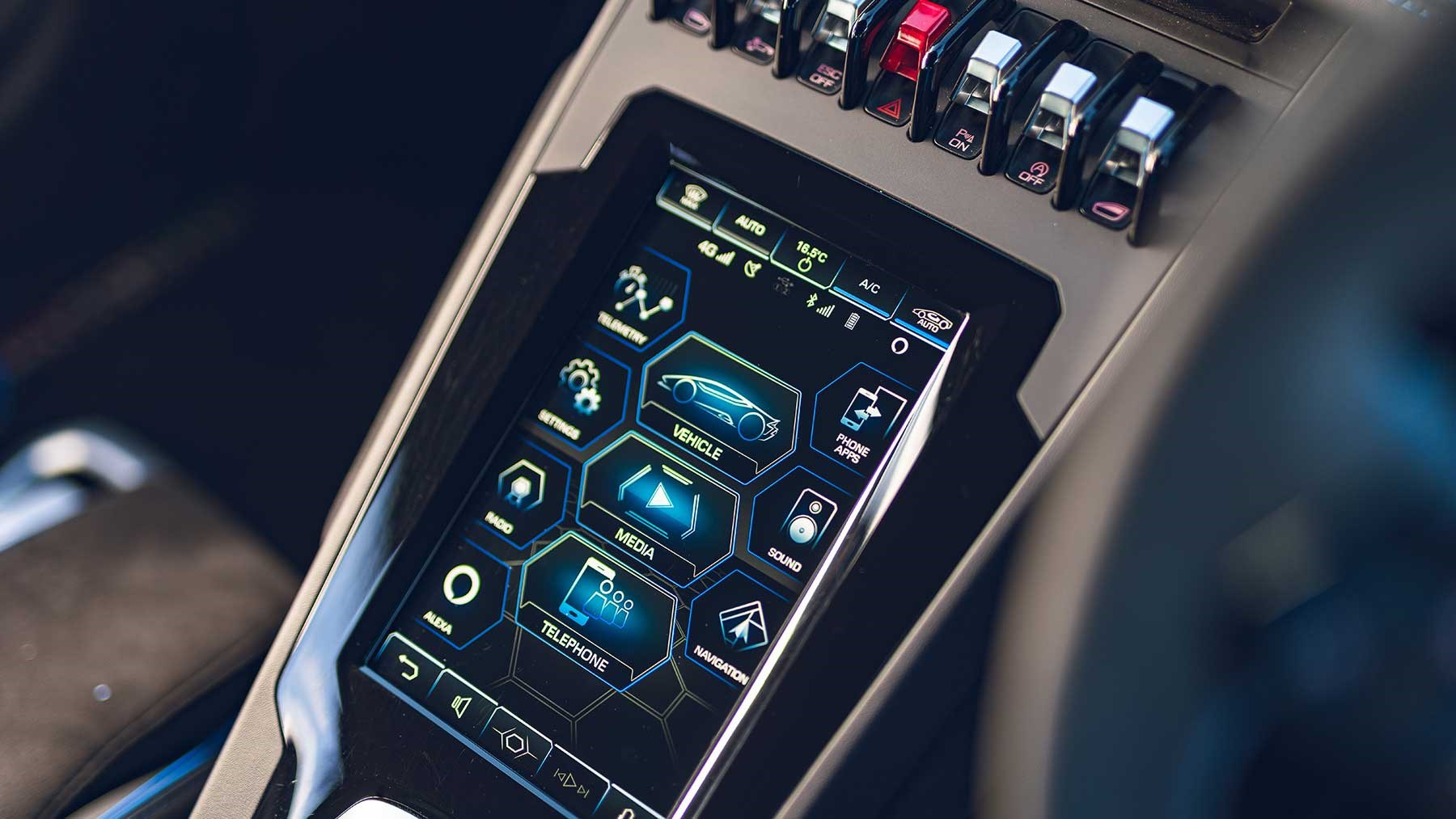
The interface is Lamborghini’s own system, developed in-house so they can update it as and when they see fit without going through a third party, and its party tricks include menus for the climate control, seat heating, Apple CarPlay and web radio (so if you’re in Bahrain, as we were on the original launch, you needn’t miss Popmaster on Radio 2).
A telemetry function is an option, including two on-board cameras, so you can record your best laps on trackdays around the world and swap data with like-minded Huracan Evo-owning mates via a dedicated app.
Naturally aspirated V10 brawn: specs and engineering details
The biggest changes that marked the Huracan Evo out from what went before are the bits you can’t see. Inside the engine, for starters.
The Huracan’s wondrous 5.2-litre V10 remains naturally aspirated, thankfully, and is now, in essence, in the same specification as the formidable lump in the previous Lamborghini Huracan Performante, titanium intake valves, lightened exhaust system and all. As a result, it now delivers a heady 631bhp at an even headier (and fantastic-sounding) 8000rpm, compared with ‘just’ the 602bhp the previous standard Huracan had to play with.
The Huracan Evo is also the first V10-engined Lamborghini to feature all-wheel steering. The system’s been seen previously on the Huracan’s bigger sibling, the V12 Aventador S and SVJ, but this is the first time the baby Lambo has steered from the rear, boosting agility at low speeds and stability at high – you know the drill.
The rear-steer system is integrated into a complex suite of electronics, which comprise the other big news for the Huracan: a new computer control system.
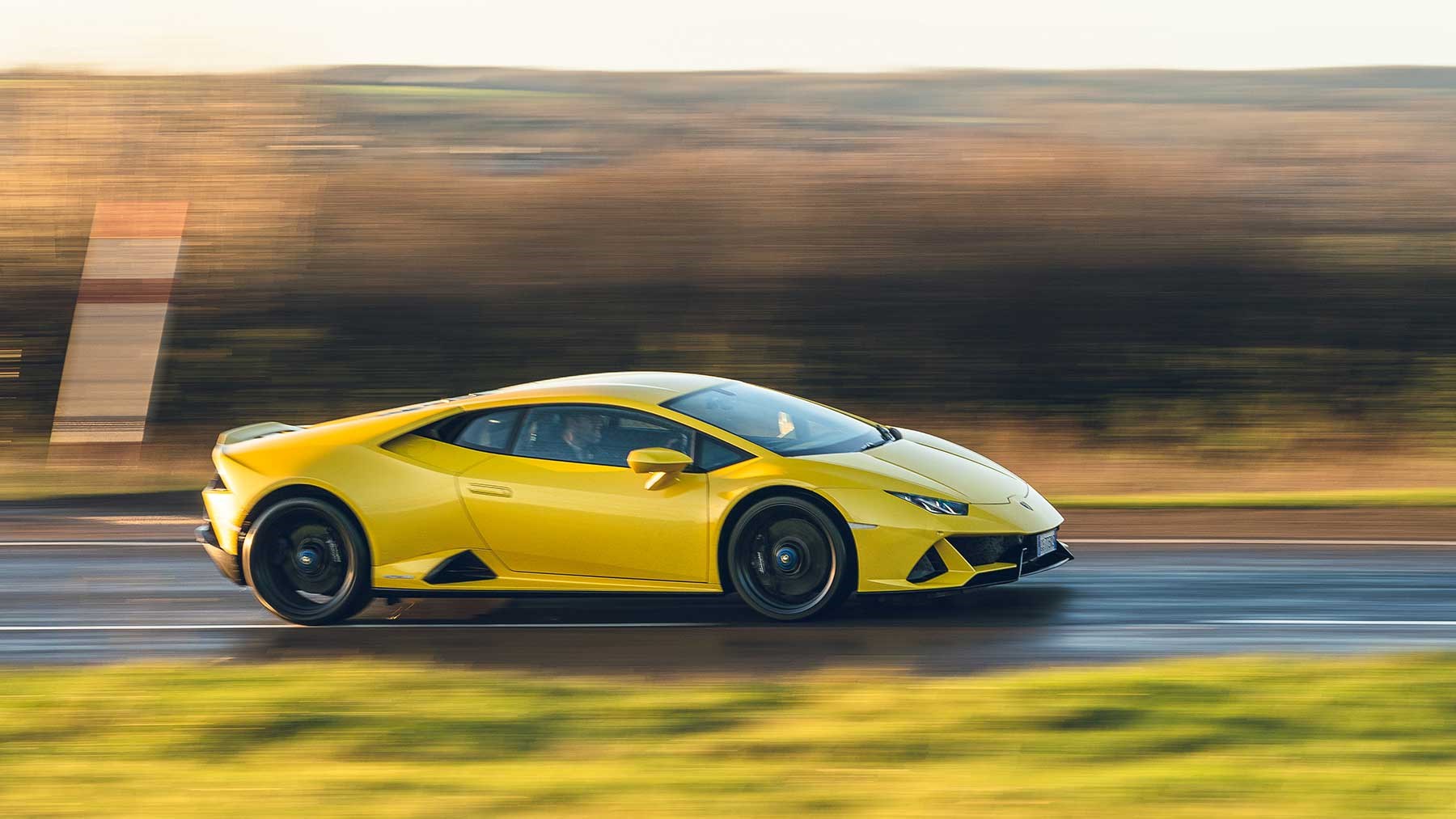
Said ’leccy grey matter is powered by a new ‘predictive logic’ vehicle dynamics control system called Lamborghini Dinamica Veicolo Integrata (LDVI), a CPU that controls all dynamic aspects of the Huracan.
That includes its brand-new torque vectoring system (able to govern the powertrain’s torque split not only front to rear, but also side to side, sent to the individual wheel that needs it most at any given time), its active suspension with electromagnetic dampers, its variable ratio electric power steering, and its various accelerometers and gyroscopic sensors which Lamborghini claim can pre-empt the driver’s next move by monitoring their inputs on the pedals, steering and transmission, and priming its suspension and powertrain accordingly.
Yet more electronics… hmm. How does this all affect how the Huracan feels to drive?
It’s changed it – for the better. The previous standard Huracan was one-dimensional to drive on the road, prioritising traction-biased understeer over front-end bite and feeling a little inert as a result. The Evo is far more nuanced, malleable and playful.
Our first test took place upon the Sakhir Grand Prix circuit in Bahrain (orange car pictured in our gallery) and on the circuit’s long, fast sweepers, its throttle response felt sharper than ever, with no turbochargers to blur the precision of the arc drawn by your foot on the floor-hinged throttle pedal, and the bellowing 5.2-litre V10 feels every bit as accelerative, and sounds every bit as good, as you’d hope.
The other characteristic of the Bahrain circuit is heavy braking zones, its long underscore straights punctuated by Big Full Stops. The Huracan Evo’s improved aerodynamic balance front to rear shows in the braking zones, remaining stable under heavy deceleration. Get greedy and hit the brakes too hard and it can get loose like most road cars, but only under extreme duress and it’s easily corrected by the fast steering and modulated by the standard-fit carbon ceramic brakes. They work well on road and don’t grumble or squeak, unlike some composite set-ups we drive.
Variable-ratio ‘Dynamic steering’, previously an odd, artificial-feeling option is now standard fit on the Huracan (it’s the only way to integrate the four-wheel steer and various other facets of the LDVI system), but on the circuit it feels natural, fast-acting and feelsome.
Now we’ve lived with the Huracan Evo on British roads, we can vouch for a good set-up; not as feelsome as a McLaren’s hydraulic rack, maybe, but accurate, alive and with a tactile Alcantara wheel that’s lovely to hold. Just a shame about those pesky indicator and wiper buttons situated on the spokes; our video above explains why they’re fiddly and tricky to use on the go.
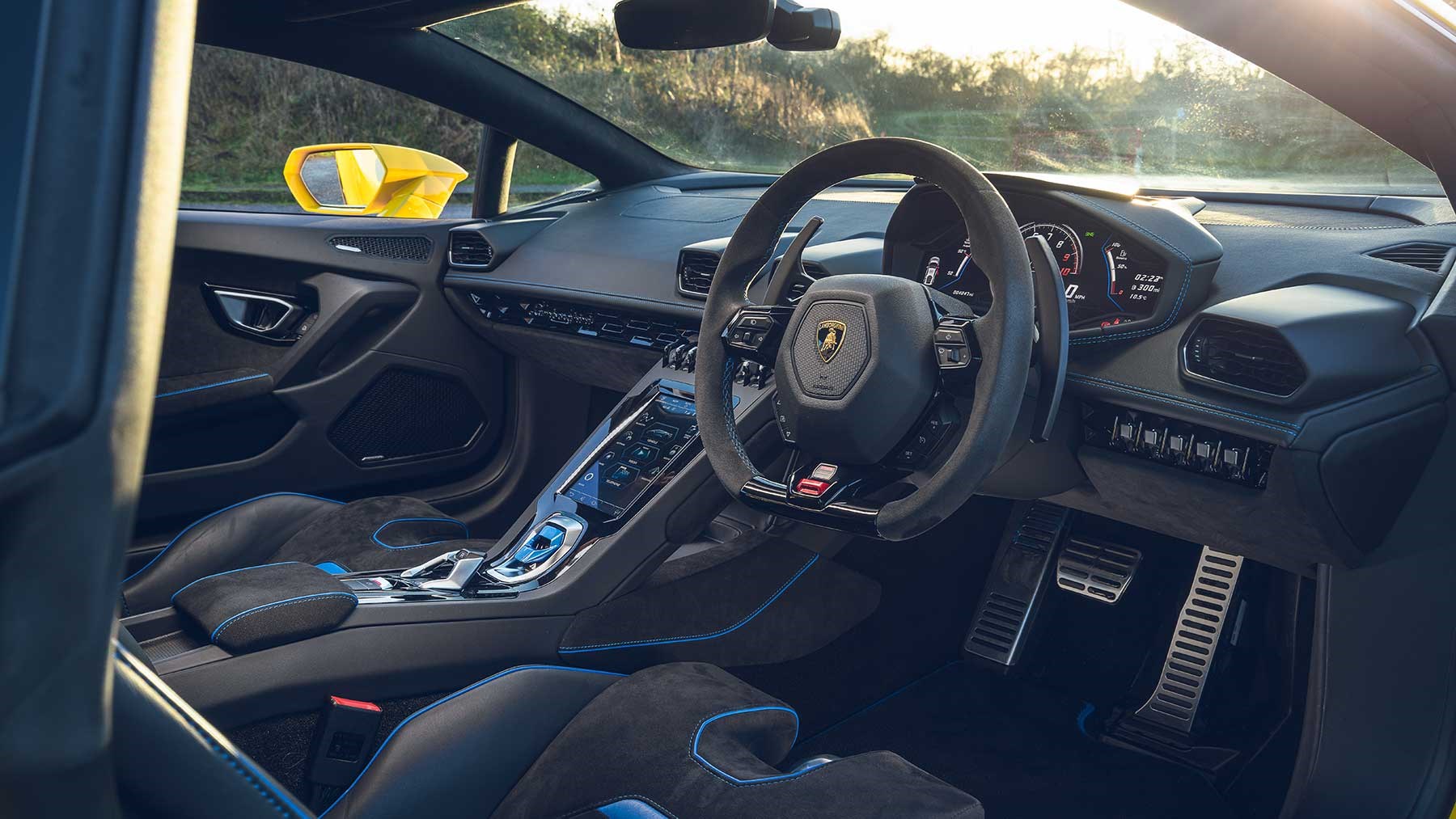
Now we’ve lived with this car for several months for our extended Lamborghini Huracan Evo review, we can vouch that it’s a lot of fun to drive, whether you’re popping to the shops or threading it along your favourite back road.
Turn-in feels sharper than before, partly a result of the increased downforce over the front axle, partly the new-generation Pirelli P Zero tyres and partly the torque vectoring system doing its deck-shuffling thing. Stability in high-speed corners feels more race car than road car, no doubt a result of the increased downforce which thankfully hasn’t required outsized exterior spoilers.
The Huracan still does the mid-engined thing of rotating if you get into a corner hot and need to lift, but it gives you plenty of warning and time to sort it out. Not that we’ve got anywhere near those levels on the road, where all-wheel drive traction and a decent ride are order of the day.
As before, there are three driving modes, selected via a toggle switch at the base of the steering wheel: Strada, Sport and Corsa. Strada is the comfort-biased road mode, Sport the one to select if you fancy a bit of oversteer and some snap-crackle-pop exhaust histrionics, and Corsa the fast-lapping max-traction, max-accuracy mode for track use.
Traction in Corsa mode is of the pull-your-face-off, pull-the-horizon-in variety, but in Sport mode the Huracan is surprisingly tail-happy, and easy to hold in a slide, its suite of electronic systems working in harmony to help you into a drift, if it detects that’s what you want to do, and get you out of it smoothly. It’s quite uncanny in operation – almost as if it really can tell what you want to do before you do it.
Lamborghini Huracan Evo: does the rear-wheel steering really make a difference?
We tested a pre-Evo standard Huracan and a new Evo back-to-back on steering pad and slalom tests – and the new car feels markedly more agile, requiring less lock, finding its apex more quickly and hanging onto it where the older car washes into understeer, and carrying more minimum corner speed as a result. It’s made a difference.
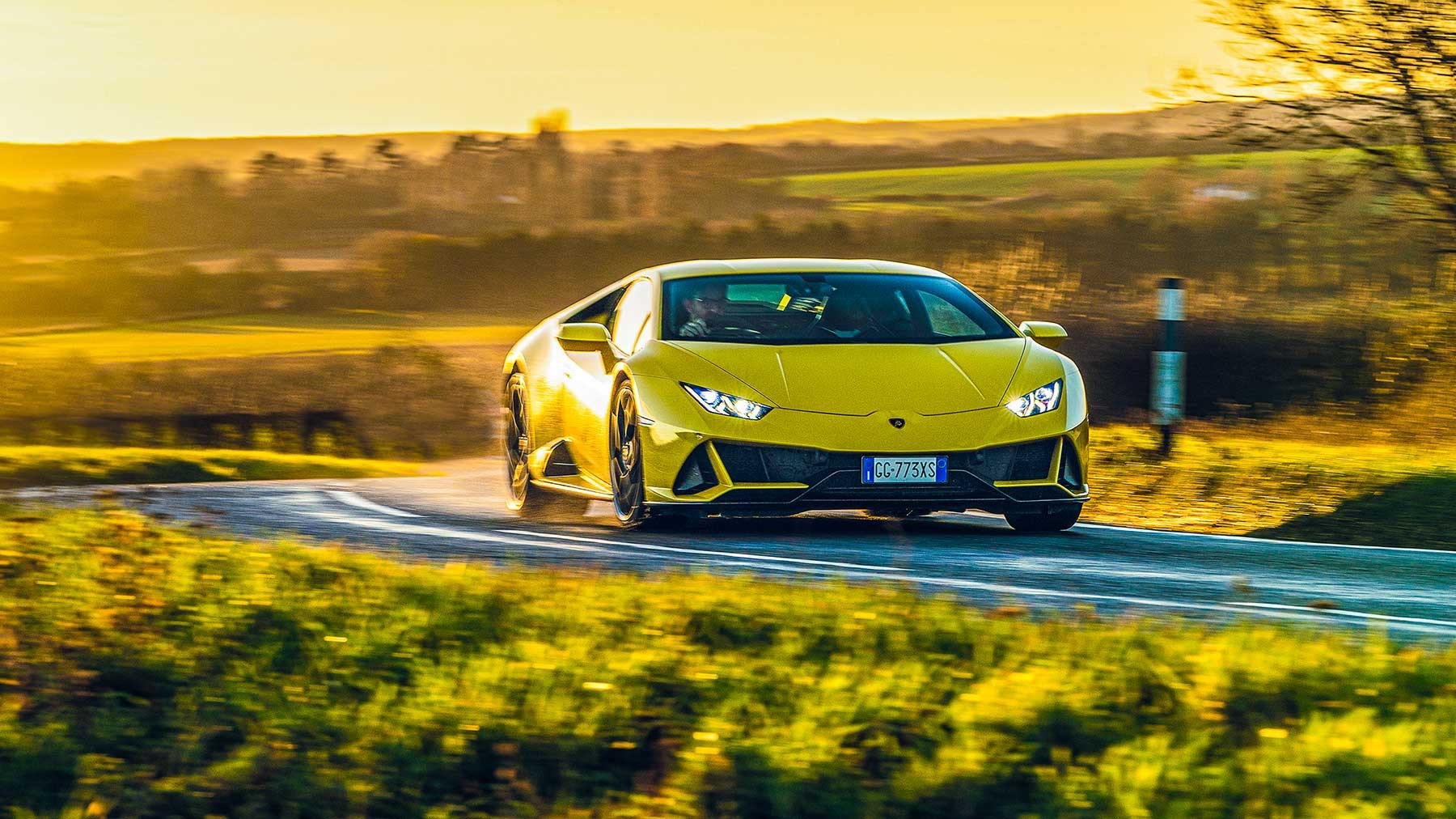
You can’t get a manual Huracan – only a paddle-shift auto box. Pause, for a moment, to consider the label on that dual-clutch transmission. LDF sounds way cooler than PDK or DSG, doesn’t it? Lamborghini Doppia Frizione swills around your mouth with all the aural perfection, the Mediterranean bounce of the Romance mother tongue.
The very Italianness of the Huracan proves a heady temptation when you live with one every day. That our car rides on Italian plates yet has the steering wheel on the correct side is the icing on the cake.
Verdict
The Huracan Evo AWD costs £198,787 for a base model; prices have crept up since the original Huracan burst on to the scene a decade ago costing £186,760. It’s a lot of money to splash on an entry-level supercar – but living with this shocking yellow Giallo Belenus example has convinced us it’s worth the cash.
The majority of the 350 Lamborghinis sold in the UK in a typical year are financed and ours would cost you £1200 a month on PCP, spread over three years with a chunky £25,000 deposit and 9.5% APR loan rate.
Where Ferrari and McLaren have switched to turbocharged – and increasingly electrified – powertrains, preferring more modest V8 or V6 engines, the Huracan is the last gasp of the big, naturally aspirated supercar. Its thundering V10 dominates proceedings and it’s now in its twilight months: a hybridised successor will be announced in 2024.
Would we recommend buying such an old-school dinosaur? Some may find rivals from Italy or Britain more exciting or technically polished, but we’re won over by the visceral simplicity of the Lamborghini Huracan Evo. To judge the Huracan in dispassionate better-than, worse-than terms is to miss the point. It’s always been an almost unbearably charismatic machine, and it now has the dynamic chops to back up its delectable styling and old-school engine.
More Lamborghini reviews by CAR magazine